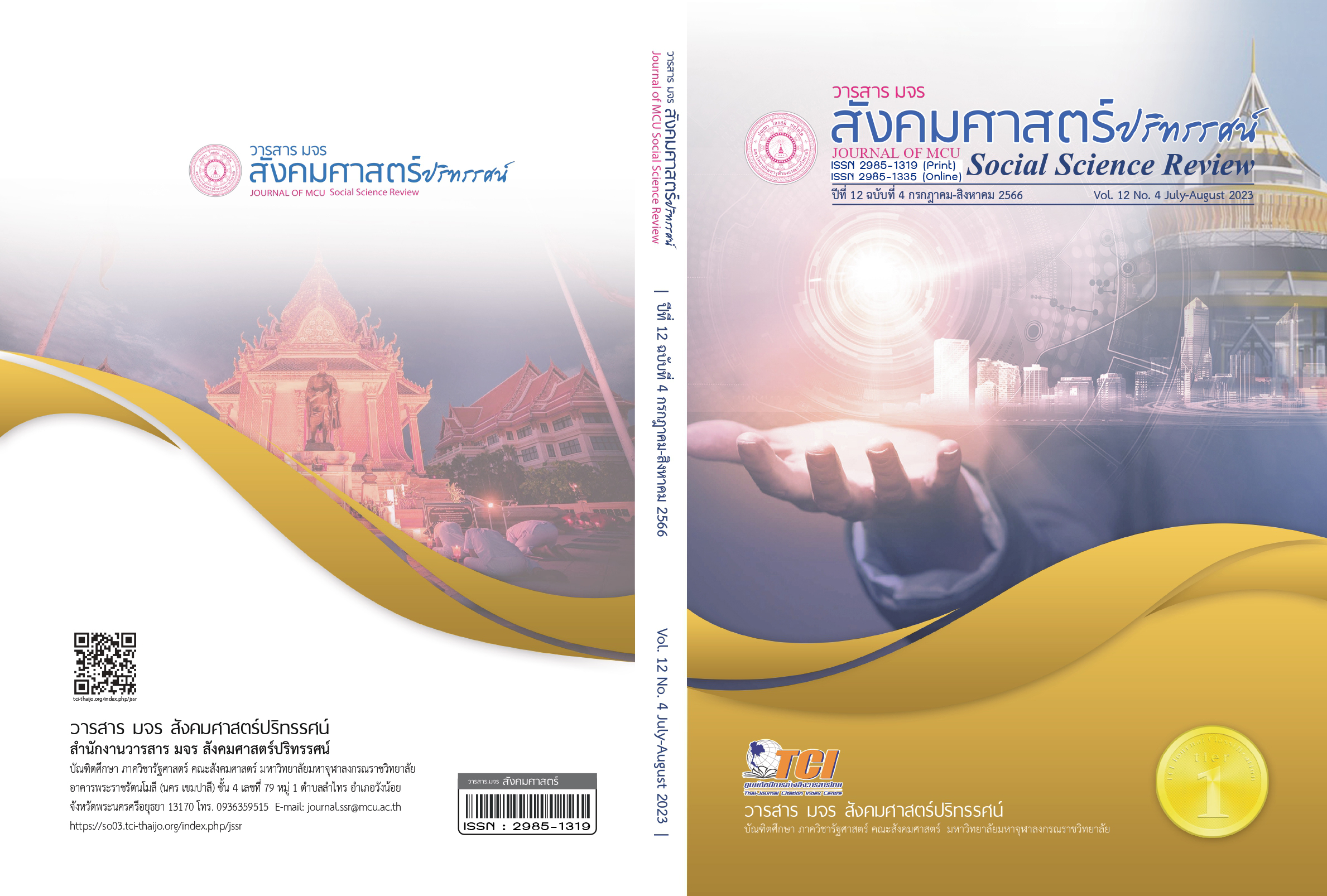วิธีการเผยแพ่ธรรมะของคณะสงฆ์ ณ อำเภอกำปงโรจังหวัดสวายเหรียง ประเทศกัมพูชา
คำสำคัญ:
วิธีการเผยแพ่ธรรมะ, คณะสงฆ์, อำเภอกำปงโรบทคัดย่อ
วัตถุประสงค์หลักของการวิจัยครั้งนี้คือ 1. เพื่อศึกษาวิธีการเผยแพ่ธรรมะของคณะสงฆ์ ใน อำเภอกำปงโร จังหวัดสวายเหรียง ประเทศกัมพูชา 2. ศึกษาปัจจัยที่มีผลกระทบต่อวิธีการเผยแพ่ธรรมะของคณะสงฆ์ ใน อำเภอกำปงโร จังหวัดสวายเหรียง ประเทศกัมพูชา 3. เสนอวิธีการเผยแพ่ธรรมะของคณะสงฆ์ในอำเภอกำปงโร จังหวัดสวายเหรียง ประเทศกัมพูชาระเบียบวิธีเป็นวิธีผสม การวิจัยเชิงปริมาณ เก็บรวบรวมข้อมูลจาก 138 ตัวอย่างโดยได้มาจากพระภิกษุสามเณร 210 รูปที่ ตำบลกำปงรู จังหวัดสวายเหรียง ประเทศกัมพูชา โดยใช้สูตร Taro Yamane ด้วยแบบสอบถามที่มีค่าความน่าเชื่อถือเท่ากับ 0.804 สถิติที่ใช้ในการวิเคราะห์ข้อมูล ได้แก่ ความถี่ร้อยละค่าเฉลี่ยการหารมาตรฐาน (S.D) และสมมติฐานที่ทดสอบโดยการถดถอยพหุคูณ สำหรับการวิจัยเชิงคุณภาพรวบรวมข้อมูลจากผู้ให้ข้อมูลหลัก 15 คนโดยการสัมภาษณ์เชิงลึกและวิเคราะห์ข้อมูลโดยการตีความเชิงพรรณนา
นโยบายการเผยแผ่ธรรมะไปใช้ในเขต เจ้าอาวาสในเขตควรมีความใกล้ชิดกับฆราวาสมากขึ้น คณะสงฆ์ควรมีเครือข่ายการสื่อสารที่ดีกับเจ้าอาวาสท่านอื่น ๆ คณะสงฆ์ เจ้าอาวาส และฆราวาสควรส่งเสริมความเข้าใจอันดีซึ่งกันและกัน และมีส่วนสนับสนุนให้ยึดหลักคำสอนของพระพุทธเจ้าและเผยแพ่ธรรมในเขตของตนให้บรรลุผลตามแผนที่วางไว้เพื่อการเผยแผ่ธรรมที่ประสบผลสำเร็จสูงสุดในชุมชน
เอกสารอ้างอิง
Dy Khamboly et al. (2007). A History of Democratic Kampuchea. Documentation Center of Cambodia.
Ian Harris. (2005) Cambodian Buddhism: History and Practice. University of Hawai'i Press.
Phra Sunthorn Ratanapanyo (Matiyapak). (2005). A Study of the Problems of Language Communication for Dhamma Propagation at the Present (Thesis of Master of Arts). Ayutthaya: Mahachulalongkornrajavidyalaya University.
Phrakhru Baidika Chitawat Thawatchayo (Thonnan). (2011). The Efficiency of Buddhist Propagation of Missionary Monks in The Educational Institution of Nakhornchaisri District, Nakhorn Pathom Province (Thesis of Master of Arts Buddhist Management). Ayutthaya: Mahachulalongkornrajavidyalaya University.
Phramaha Rungphet Chawanpanyo (Patthap). (2005). A Study of Patterns And Methods for Propagation Buddhadhamma Of Phradhammakittiwong (Thongdee Suratejo) (Thesis of Master of Arts Buddhist Management). Ayutthaya: Mahachulalongkornrajavidyalaya University.
Phra Banchob Dhirawangso. (2006). A Study of the Role and Works of Phrakru Sutasarapimol (Pimpa Dhammadinno) (Thesis of Master of Arts Buddhist Management). Ayutthaya: Mahachulalongkornrajavidyalaya University.
Phramaha Thanachai Tantipalo (Sannarong). (2011). The Roles on Propagation of Phra Vikrommunee (Boonrod Panyavaro) (Thesis of Master of Arts Buddhist Study). Ayutthaya: Mahachulalongkornrajavidyalaya University.
Sarun Pov. (2016). The Role of Buddhism in Peacebuilding and Development of the Cambodian Society: A Case Study of the Contribution Done By Venerable Maha Ghosananda (Thesis of Master of Arts International Buddhist Studies College). Ayutthaya: Mahachulalongkornrajavidaya University.
Sar Sarin. (2018). January 7, 1979 - January 7, 2018 is my second birthday for 39 years. Retrieved from http://www.khmerrougehistory.org/
Yamane, T. (1967). Statistics An Introductory Analysis. New York, Harper, and Row.
Youk Chhang. (1979). Phnom Penh Liberation. Documentation Center of Cambodia.
ดาวน์โหลด
เผยแพร่แล้ว
รูปแบบการอ้างอิง
ฉบับ
ประเภทบทความ
สัญญาอนุญาต
ลิขสิทธิ์ (c) 2023 วารสาร มจร สังคมศาสตร์ปริทรรศน์

อนุญาตภายใต้เงื่อนไข Creative Commons Attribution-NonCommercial-NoDerivatives 4.0 International License.
เพื่อให้เป็นไปตามกฎหมายลิขสิทธิ์ ผู้นิพนธ์ทุกท่านต้องลงลายมือชื่อในแบบฟอร์มใบมอบลิขสิทธิ์บทความให้แก่วารสารฯ พร้อมกับบทความต้นฉบับที่ได้แก้ไขครั้งสุดท้าย นอกจากนี้ ผู้นิพนธ์ทุกท่านต้องยืนยันว่าบทความต้นฉบับที่ส่งมาตีพิมพ์นั้น ได้ส่งมาตีพิมพ์เฉพาะในวารสาร มจร สังคมศาสตร์ปริทรรศน์ เพียงแห่งเดียวเท่านั้น หากมีการใช้ภาพหรือตารางหรือเนื้อหาอื่นๆ ของผู้นิพนธ์อื่นที่ปรากฏในสิ่งตีพิมพ์อื่นมาแล้ว ผู้นิพนธ์ต้องขออนุญาตเจ้าของลิขสิทธิ์ก่อน พร้อมทั้งแสดงหนังสือที่ได้รับการยินยอมต่อบรรณาธิการ ก่อนที่บทความจะได้รับการตีพิมพ์ หากไม่เป็นไปตามข้อกำหนดเบื้องต้น ทางวารสารจะถอดบทความของท่านออกโดยไม่มีข้อยกเว้นใดๆ ทั้งสิ้น





